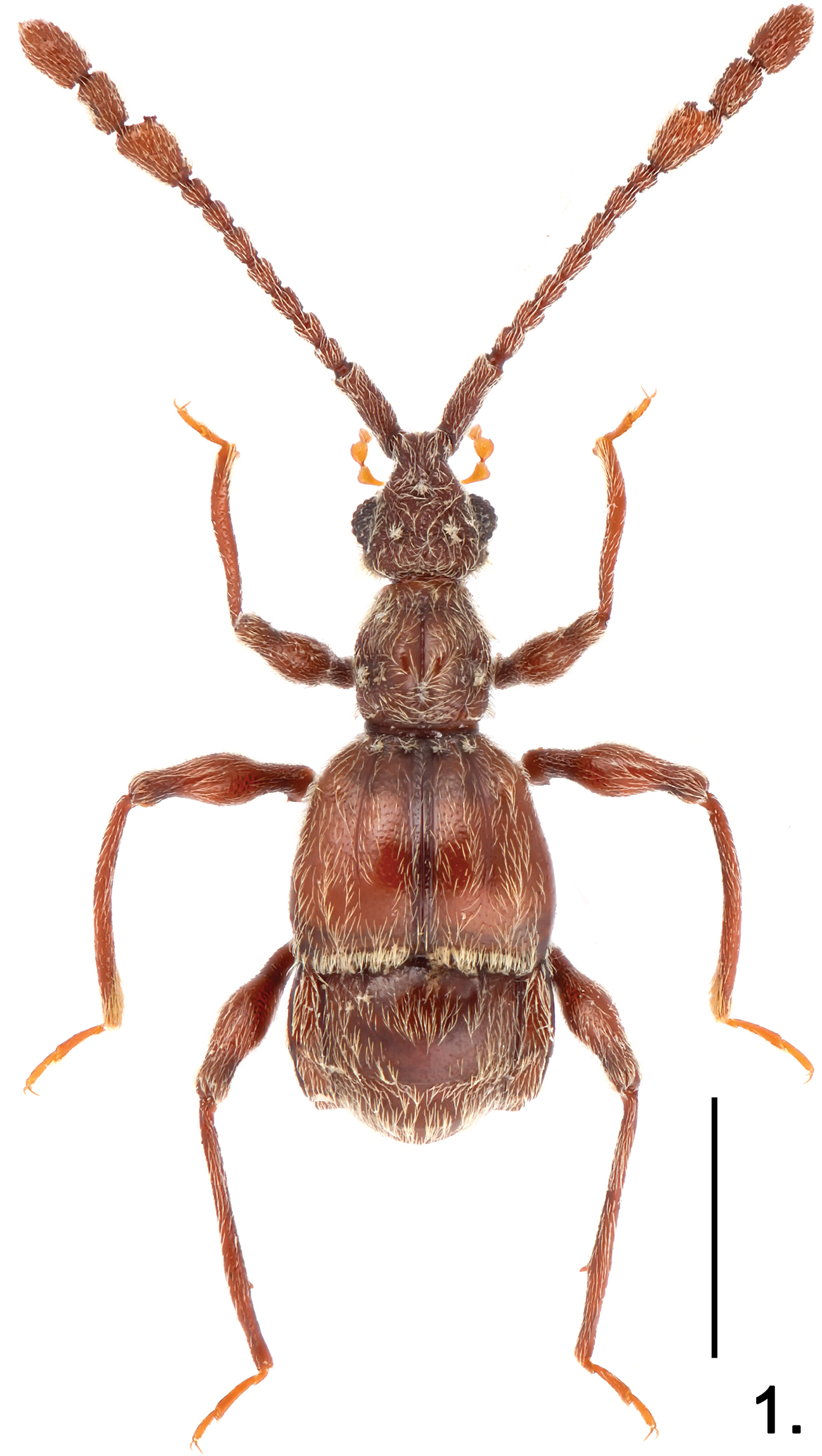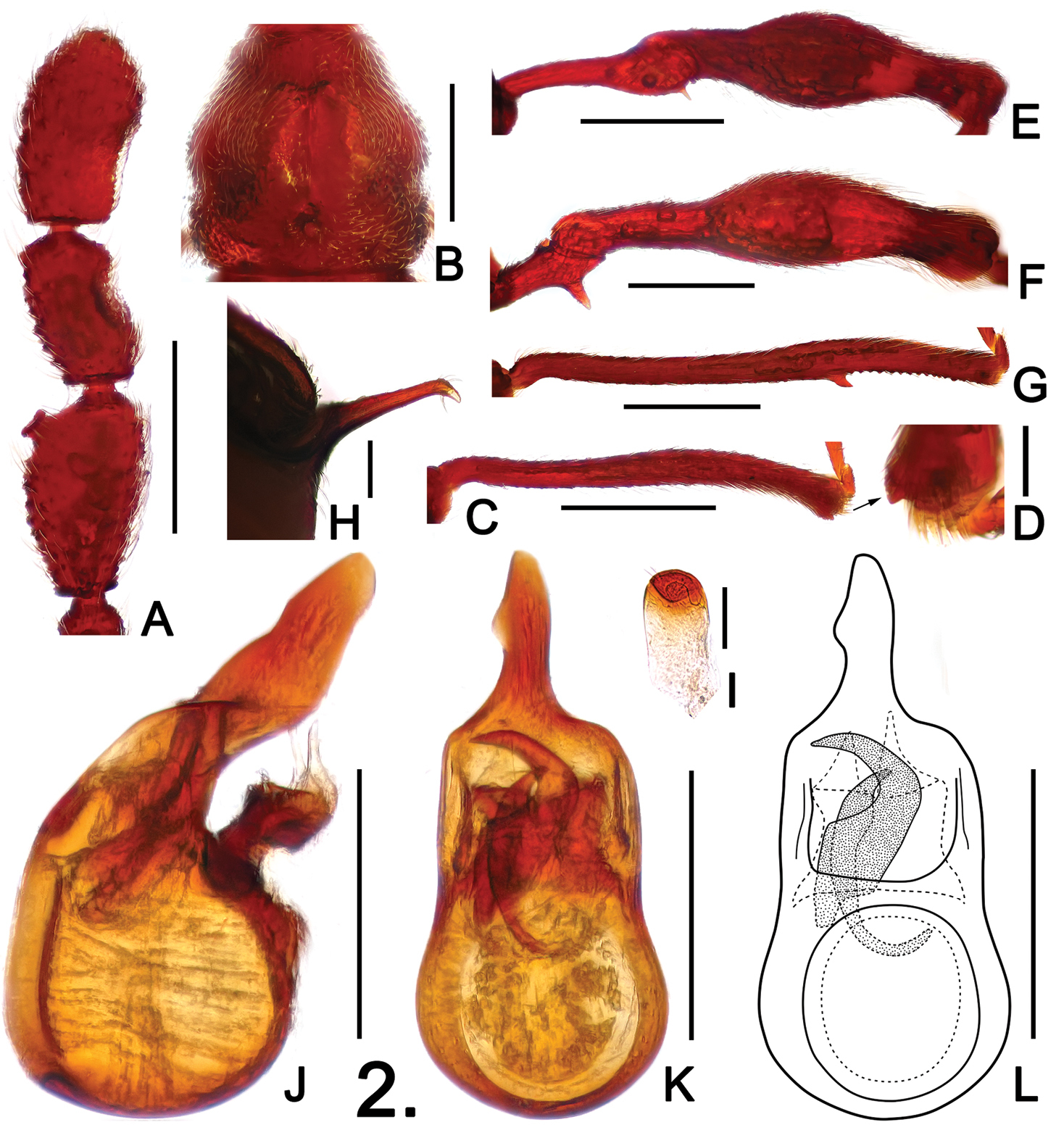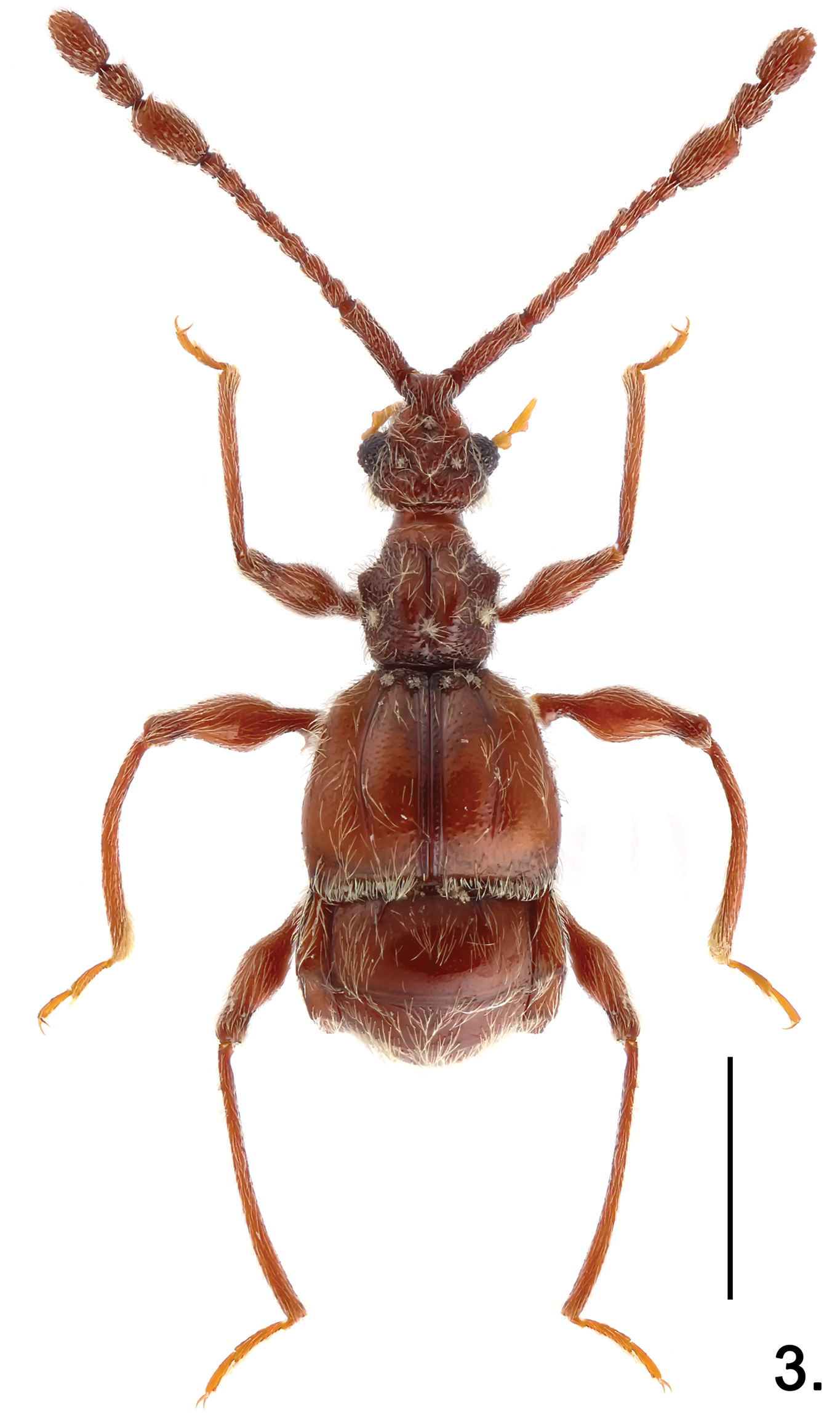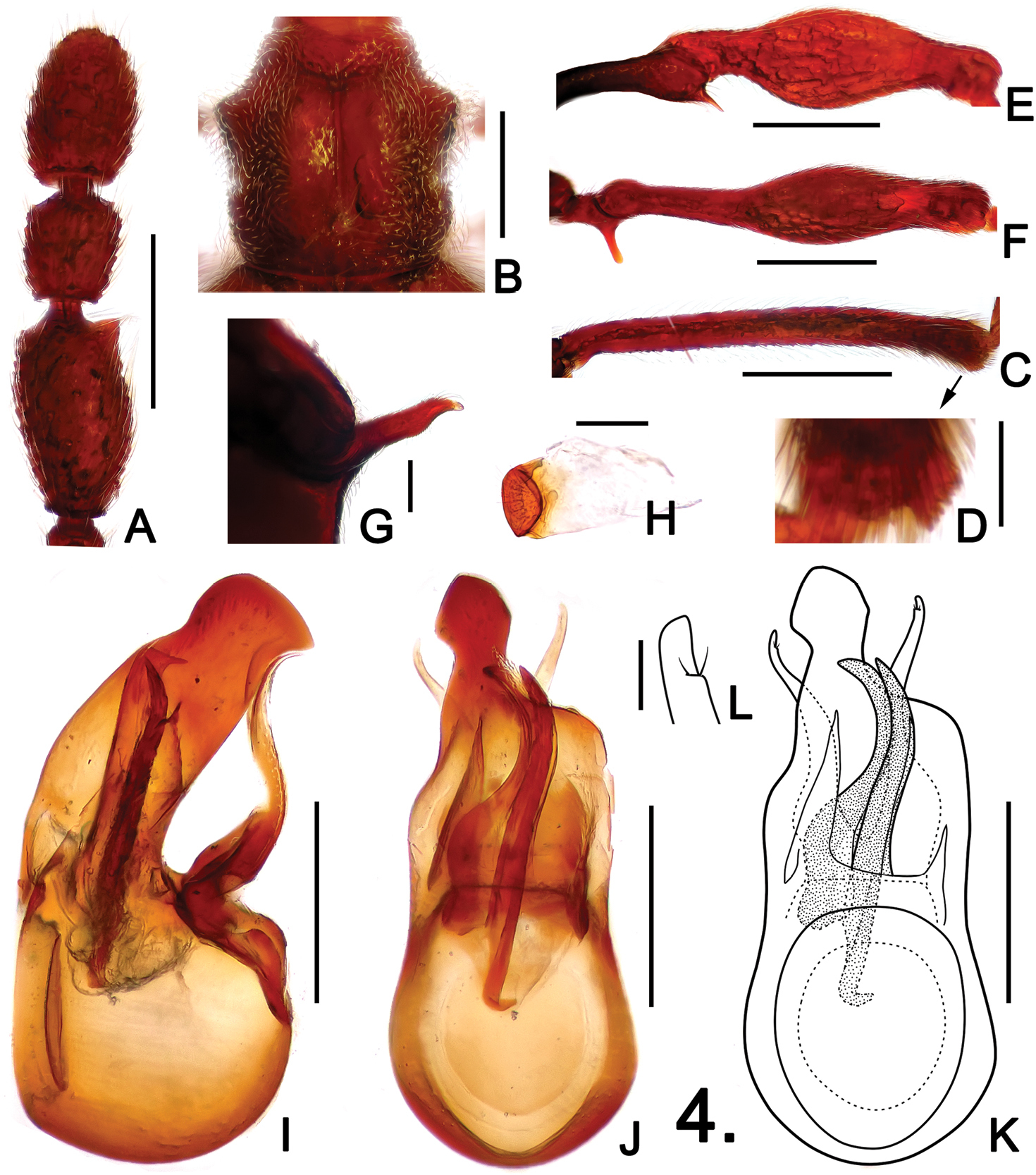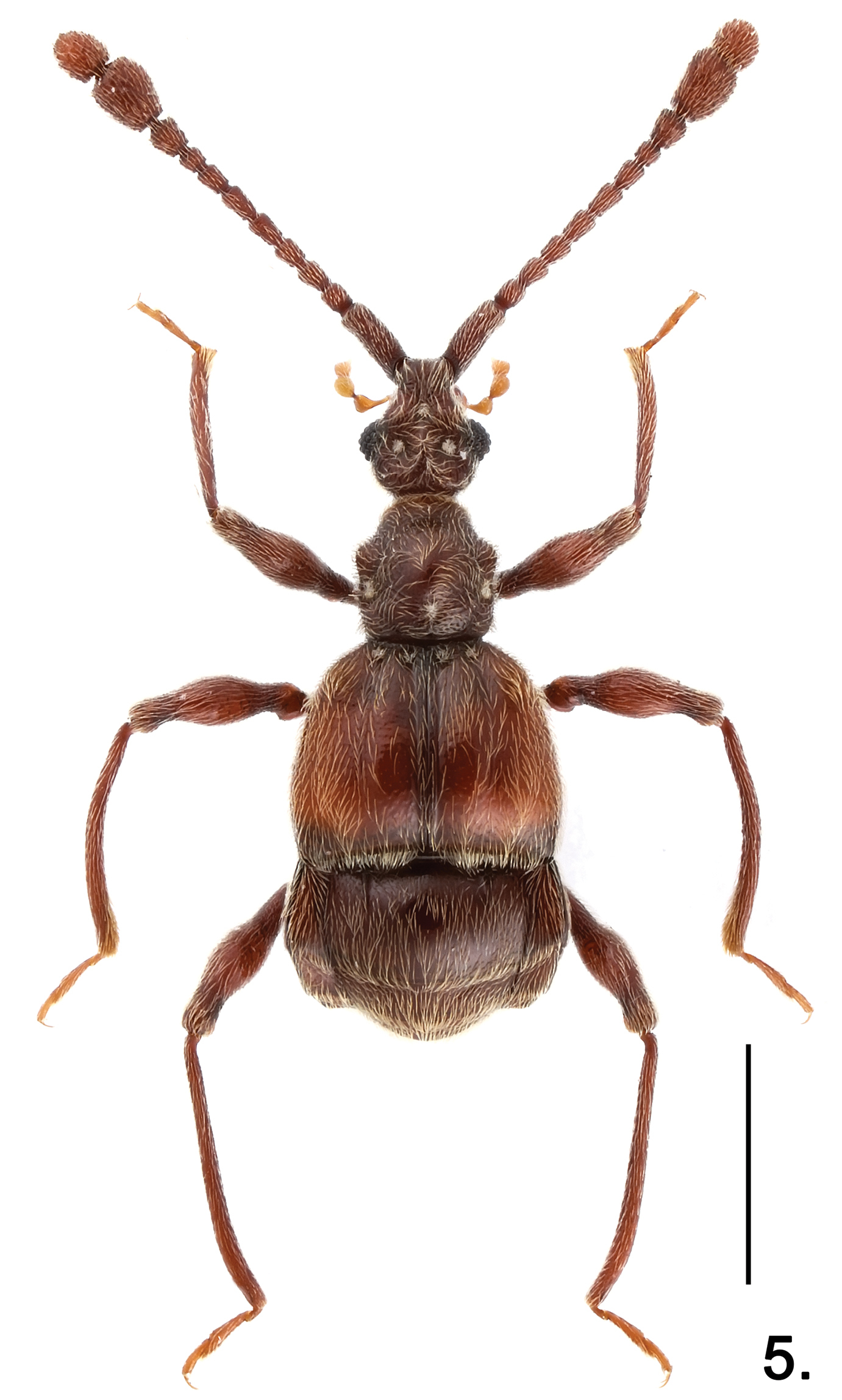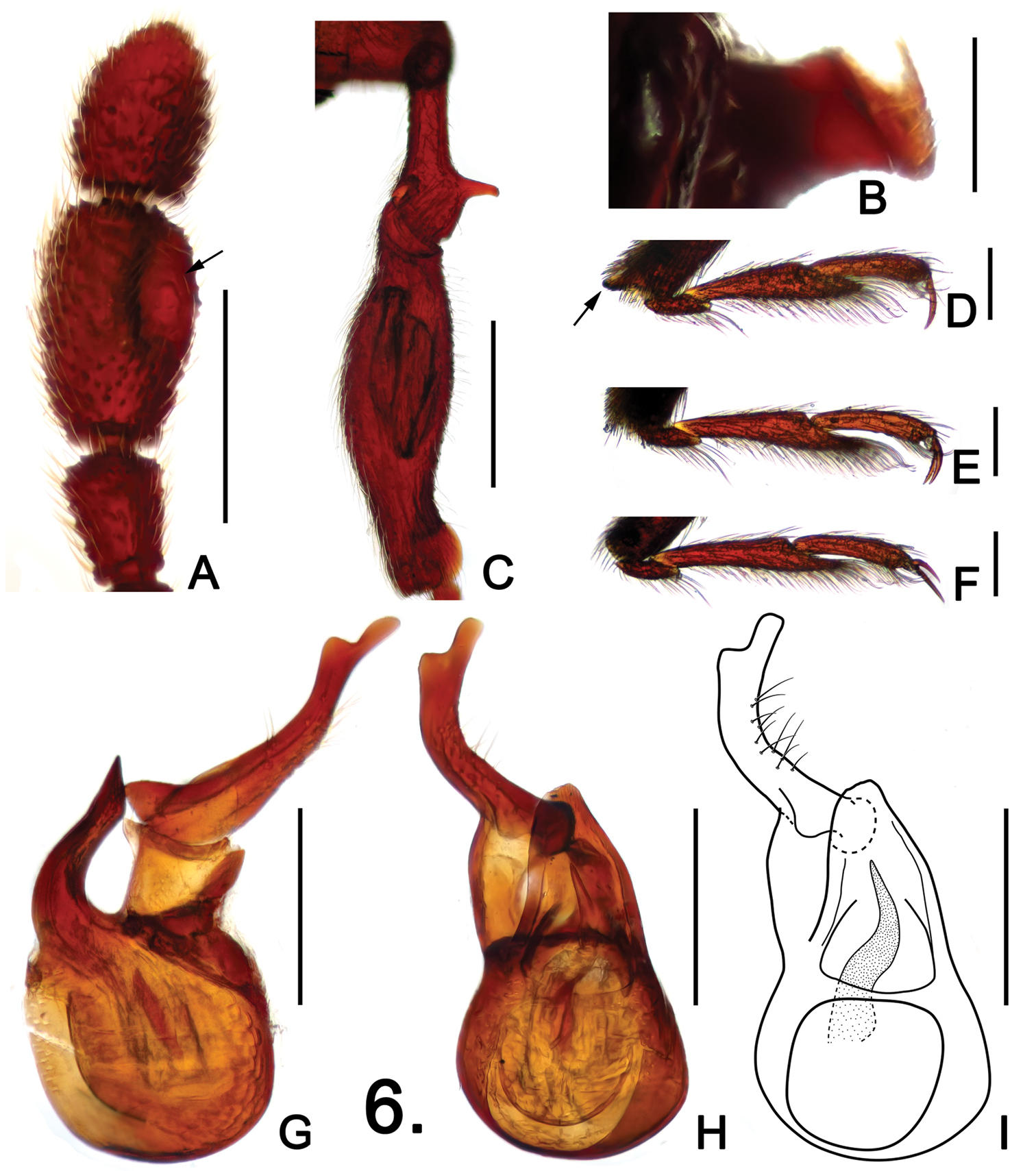






(C) 2012 Zi-Wei Yin. This is an open access article distributed under the terms of the Creative Commons Attribution License 3.0 (CC-BY), which permits unrestricted use, distribution, and reproduction in any medium, provided the original author and source are credited.
For reference, use of the paginated PDF or printed version of this article is recommended.
Two new species, Pselaphodes linae Yin & Li, sp. n. (Hainan, Fujian) and Pselaphodes shii Yin & Li, sp. n. (Hainan) are described from South China. Taiwanophodes minor Hlaváč is reported from outside Taiwan for the first time. Illustrations of major diagnostic features are provided for all treated taxa. The latest key to Chinese Pselaphodes is modified to include the new species.
Staphylinidae, Pselaphinae, Pselaphodes, Taiwanophodes, taxonomy, new species, new record, South China
A number of tyrine specimens have been submitted for determination since the publication of our previous papers of the genus Pselaphodes Westwood (
The terminology of foveal system follows
A slash (/) is used to separate lines on the same label, and a double slash (//) is used to separate different labels on the same pin.
Measurements are in millimeter, the following acronyms are used in the text: AL–length of the abdomen along the midline; AW–maximum width of the abdomen; BL–length of the body (= HL + PL + EL + AL); EL–length of the elytra along the sutural line; EW–maximum width of the elytra; HL–length of the head from the anterior clypeal margin to the occipital constriction; HW–width of the head across eyes; PL–length of the pronotum along the midline; PW–maximum width of the pronotum.
The type series are deposited in the Insect Collection of Shanghai Normal University, Shanghai, China (SNUC).
Taxonomyurn:lsid:zoobank.org:act:7C845FB3-6BEA-4CEC-91CC-75805DF662BE
http://species-id.net/wiki/Pselaphodes_linae
Figs 1, 2China, Hainan Province, Wuzhishan Mountain.
(11 ♂♂, 5 ♀♀). HOLOTYPE: ♂, labeled ‘CHINA: Hainan Prov. / Wuzhishan Mt. / Guzhandao / ca. 640 m, 30.xi.2009 / 18.86657°N, 109.68285°E / Mei-Ying Lin leg. // [red] HOLOTYPE / Pselaphodes linae Yin & Li / det. 2012, SNUC’. PARATYPES (all bear the following label: ‘[yellow] PARATYPE / Pselaphodes linae Yin & Li / det. 2012, SNUC’): 2 ♂♂, 3 ♀♀, same label data as holotype; 2 ♂♂, 1 ♀, labeled ‘CHINA: Hainan Prov. / Yinggeling N. R. / Daoyin–Shenfu / ca. 425 m, 22.xi.2009 / Mei-Ying Lin leg.’; 1 ♀, same label data, except ‘14.IV.2010 / 18.98399°N, 109.33585°E’; 5 ♂♂, labeled ‘CHINA: Hainan Prov. / Baisha, Yuanmen / Yinggeling N. R. / Yinggezui / 660 m, 26.iv.2011 / Wen-Xuan Bi leg.’; 1 ♂, labeled ‘CHINA: Fujian Prov. / Nanjing County / Huboliao / ca. 200 m, 22.xi.2008 / Gan-Yan Yang leg. (beating)’.
Reddish brown; medium-sized; genae rounded; antennomeres IX–XI strongly modified; pronotum with rounded lateral margins; with thin and long metaventral processes (in lateral view); pro- and metatibiae sinuate; aedeagus with asymmetric median lobe and small parameres.
Male (Fig. 1). Length 2.65–2.87. Head as long as wide, HL 0.56–0.58, HW 0.56–0.58; eyes large, each composed of about 40 facets. Antennal clubs as in Fig. 2A. Pronotum (Fig. 2B) slightly longer than wide, PL 0.55–0.56, PW 0.50–0.52, with round lateral margins. Elytra wider than long, EL 0.80–0.81, EW 0.99–1.04. Metaventral horn-like processes long (Fig. 2H). Legs having protibiae with blunt and slightly serrate apical projection (Figs 2C, D); mesotrochanters with minute ventral spine (Fig. 2E); metatrochanters with large robust spine (Fig. 2F). Abdomen large, AL 0.74–0.92, AW 1.00–1.02. Sternite IX as in Fig. 2I. Aedeagus length 0.39; with long asymmetric median lobe; apical half of parameres membranous (Figs 2J–L).
Female. Similar to male in general; BL 2.60–2.75, HL 0.56–0.58, HW 0.53–0.57, PL 0.56–0.58, PW 0.50–0.52, EL 0.67–0.70, EW 0.98–1.04, AL 0.81–0.89, AW 1.05–1.09. Eyes each composed of about 30 facets. Antennae simple; protibiae not spinose; metaventral horn-like processes absent.
Habitus of Pselaphodes linae. Scale: 1.0 mm.
Details of male Pselaphodes linae. A right antennal club B pronotum C protibia D apex of protibia, enlarged E mesotrochanter and mesofemur F metatrochanter and metafemur G metatibia H metaventral process, in lateral view I sternite IX J aedeagus, in lateral view K–L same, in dorsal view. Scales: A, B, C, E, F, G = 0.3 mm, H, I = 0.1 mm, D = 0.05 mm, J, K, L = 0.2 mm.
South China: Hainan, Fujian.
Very distinctive species, easily separable from all other Pselaphodes species by the sinuate pro- and metatibiae, the metatibiae with a blade-shaped ventral tooth near apical 1/3, and the serrate ventral margin for the distance posterior to the tooth. The new species shares with Pselaphodes bomiensis Yin et al., 2011 and Pselaphodes condylus Yin et al., 2011 a similar placement of the antennal modification, but can be readily separated from both by the pronotal lateral margins being rounded. On the contrary the lateral margins of the pronotum are more or less angularly expanded laterally in Pselaphodes bomiensis and Pselaphodes condylus.
The species name is dedicated to Mei-Ying Lin for the collection of part of the type series.
urn:lsid:zoobank.org:act:CE8869A2-3929-4D1B-9D4D-89407D7D026B
http://species-id.net/wiki/Pselaphodes_shii
Figs 3, 4China, Hainan Province, Jianfengling Natural Reserve
(2 ♂♂). HOLOTYPE: ♂, labeled ‘CHINA: Hainan Prov. / Ledong County / Jianfengling N. R. / Yulingu, river bank / 18.74686°N, 108.92988°E / ca. 635, 20.iii.2007 / H.L. Shi, F. Yuan leg. // [red] HOLOTYPE / Pselaphodes shii Yin & Li / det. 2012, SNUC’. PARATYPE: 1 ♂, labeled ‘CHINA: Hainan Prov / Yinggeling, Nankai / Daoyin–Mohao / ca. 335 m, 15.iv.2010 / 19.01021°N, 109.36910°E / Mei-Ying Lin leg. // [yellow] PARATYPE / Pselaphodes shii Yin & Li / det. 2012, SNUC’.
Reddish brown; medium-sized; postocular margins rounded; antennomeres IX strongly modified; pronotum angularly expanded laterally; with robust and long metaventral processes (in lateral view); aedeagus with asymmetric median lobe and long parameres.
Male (Fig. 3). Length 2.85–2.95. Head as long as wide, HL 0.56–0.60, HW 0.58–0.59; genae rounded; eyes large, each composed of about 40 facets. Antennal clubs as in Fig. 4A. Pronotum (Fig. 4B) almost as long as wide, PL 0.55–0.56, PW 0.57–0.58, with angulate anterolateral margins. Elytra wider than long, EL 0.81–0.84, EW 1.07–1.10. Metaventral horn-like processes long (Fig. 2G). Legs having protibiae with blunt and slightly serrate apical projection (Figs 2C, D); mesotrochanters with distinct ventral spine (Fig. 2E); metatrochanters with long, apically blunt spine (Fig. 2F). Abdomen large, AL 0.93–0.95, AW 1.08–1.12. Sternite IX as in Fig. 2H. Aedeagus length 0.59; with broad asymmetric median lobe and elongate parameres (Figs 4I–K).
Female. Unknown.
Habitus of Pselaphodes shii. Scale: 1.0 mm.
Details of male Pselaphodes shii. A left antennal club B pronotum C protibia D apex of protibia, enlarged E mesotrochanter and mesofemur F metatrochanter and metafemur G metaventral process, in lateral view H sternite IX I aedeagus, in lateral view J–K same, in dorsal view L right paramere, enlarged. Scales: A, B, C, E, F = 0.3 mm, D = 0.05 mm, G, H = 0.1 mm, L = 0.025 mm, I, J, K = 0.2 mm.
South China: Hainan.
This species is placed close to Pselaphodes bomiensis, Pselaphodes condylus and Pselaphodes jizushanus Yin et al., 2011 by sharing a similar placement of the antennal modification and projected anterolateral margins of the pronotum. It can be readily separated from Pselaphodes bomiensis and Pselaphodes condylus by the much smaller size and different form of the antennomeres IX, from Pselaphodes jizushanus by the metaventral processes being slightly curved posteriorly, the metatrochanters being protuberant ventrally and the metatibiae being simple. Pselaphodes jizushanus has the metaventral processes being curved anteriorly, the metatrochanters are simple, and the metatibiae are bluntly projected at apical 1/5.
The species is named after Hong-Liang Shi for the collection of the holotype.
The latest key to the Chinese Pselaphodes (
| 11 | Metatibiae modified in apical half (Fig. 2G; |
12 |
| – | Metatibiae simple | 14 |
| 12 | Protibiae with median or apical projection | 13a |
| – | Protibiae lacking projection. (Yunnan) | Pselaphodes jizushanus Yin, Li & Zhao, 2011 |
| 13a | Protibiae with projection near middle ( |
Pselaphodes aculeus Yin, Li & Zhao, 2010 |
| - | Protibiae with projection at apex | 13 |
| 13 | Body black ( |
Pselaphodes torus Yin, Li & Zhao, 2010 |
| – | Body reddish brown (Fig. 1); antennomeres X much longer than wide (Fig. 2-A). (Hainan) | Pselaphodes linae Yin & Li, sp. n. |
| 14 | Metacoxae protuberant | 15 |
| – | Metacoxae simple | 16 |
| 15 | Elytra with two pairs of discal humps ( |
Pselaphodes gongshanensis Yin, Li & Zhao, 2011 |
| – | Elytra lacking discal humps ( |
Pselaphodes hui Yin & Li, 2012 |
| 16 | Mesofemora simple ( |
17 |
| – | Mesofemora with tiny admesal spine ( |
Pselaphodes cornutus Yin, Li & Zhao, 2010 |
| 17 | Protrochanters simple ( |
17a |
| – | Protrochanters with distinct ventral spine ( |
Pselaphodes condylus Yin, Li & Zhao, 2010 |
| 17a | Large-sized (3.4 mm); antennae and legs conspicuously elongate ( |
Pselaphodes subtilissimus Yin, Li & Zhao, 2010 |
| – | Medium-sized (less than 3 mm); antennae and legs normally elongate (Fig. 3); meso- and metatrochanters spinose (Figs 4E, F). (Hainan) | Pselaphodes shii Yin & Li, sp. n. |
China, Taiwan, Nantou.
(2 ♂♂, 3 ♀♀). 2 ♂♂, labeled ‘CHINA: Hainan Prov. / Yinggeling, Nankai / Daoyin–Mohao / ca. 335 m, 15.iv.2010 / Mei-Ying Lin leg.’; 3 ♀♀, labeled ‘CHINA: Hainan Prov. / Wuzhishan Mt. / Guzhandao / ca. 640 m, 30.xi.2009 / 18.86657°N, 109.68285°E / Mei-Ying Lin leg.’.
Male (female): BL 2.78–2.87 (2.68–2.74), HL 0.56–0.57 (0.57–0.58), HW 0.53–0.54 (0.52–0.54), PL 0.57–0.58 (0.58–0.60), PW 0.55–0.57 (0.53–0.58), EL 0.82–0.84 (0.67–0.69), EW 1.11–1.15 (1.06–0.10), AL 0.83–0.88 (0.86–0.87), AW 1.13–1.16 (1.16–1.22), length of aedeagus 0.50.
Male. Reddish brown; medium-sized (Fig. 5); postocular margins rounded; each eye composed of about 40 facets; antennomeres X modified, ventrally concave at apical half (Fig. 6A); pronotum with angulate anterolateral margins; robust and short metaventral processes with hook-like apices (in lateral view) (Fig. 6B); protrochanters spinose ventrally; protibiae with small apical spur (Fig. 6D); tarsomeres II extending to mid-length of tarsomeres III (Figs 6D–F); aedeagus asymmetric, median lobe elongate, parameres largely reduced (Figs 6G–I).
Female. Similar to male in general; each eye composed of about 30 facets; lacking antennal modification; lacking metaventral process; apices of protibiae simple.
Habitus of Taiwanophodes minor. Scale: 1.0 mm.
Details of Taiwanophodes minor. A right antennal club B metaventral process, in lateral view C protrochanter and profemur D protasus E mesotarsus F metatarsus G aedeagus, in lateral view H–I aedeagus, in dorsal view. Scales: A, C, G, H, I = 0.3 mm, B, D, E, F = 0.1 mm.
South China: Taiwan, Hainan (New Province Record).
Readily distinguished from the only other congener Taiwanophodes magnus Bekchiev, 2010 by the smaller size, antennomeres X being less modified, pronotum being angularly expanded anterolaterally, profemora and protibiae being simple, different conformation of the metaventral processes, and aedeagus with more elongate median lobe and reduced parameres.
Taiwanophodes minor was originally described from central Taiwan (Hlaváč, 2002). It is somewhat surprising that this species also occurs in the Hainan Island, suggesting geographic affinities between the two islands.
We thank Mei-Ying Lin, Hong-Liang Shi, Wen-Xuan Bi and Gan-Yan Yang for the collection and providing of the specimens. This study is supported by the National Natural Science Foundation of China (No. 31101659) and Shanghai Normal University (No. SK201242). We thank the anonymous reviewer for comments on the paper.
